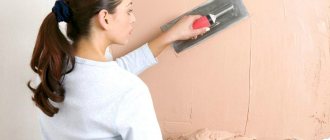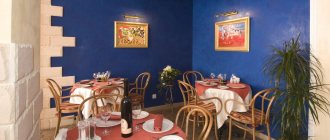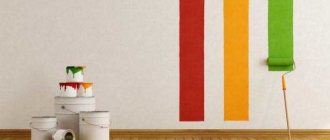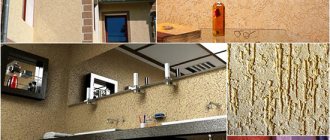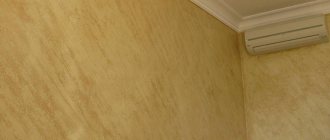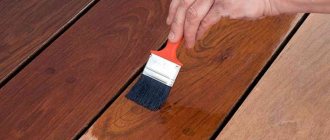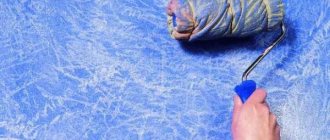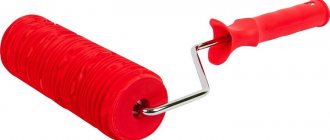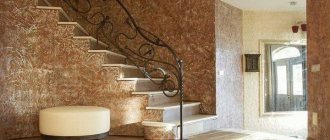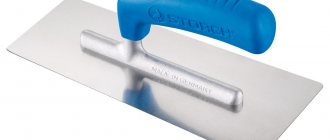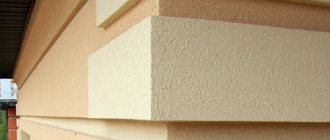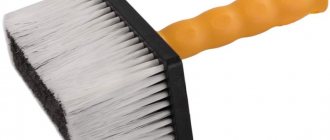One of the trends in modern renovation is textured paint. This material is successfully used by both eminent designers and ordinary apartment owners to imitate a wide variety of textures. The use of such paint has its own nuances, which are important to know before purchasing and applying.
Advantages of decorative plaster
Decorative relief plaster has 7 advantages:
- safety , non-toxicity of all types of such decorative mixtures;
- the ability to eliminate small defects on the treated surface without additional work;
- the ability to simulate different textures;
- the ability to independently work with decorative plaster for walls;
- resistance to periodic temperature changes and other climatic influences, maximum durability;
- high heat and sound insulation performance .
Comparative analysis
This table will help you make a comparative analysis of textured paint and decorative plaster, thanks to which you can see the difference and make a choice.
| Textured paint | Decorative plaster | |
| Environmental friendliness | High | High |
| Application | Simple | Medium difficulty |
| Irregularities in the base | Hides small defects | Completely hides base defects |
| Lifetime | 10-30 years | 30-60 years |
| Mechanical resistance | Average | High |
| UV resistance | Stable | Stable |
| Moisture resistance | Average | High |
| Dismantling | Medium difficulty | High difficulty |
| Reconstruction | Amenable | Amenable |
| Vapor permeability | High | Excellent |
| Flammability | Non-flammable | Does not burn |
| Appearance | Attractive | Attractive |
| Price | Expensive and average | From cheap to expensive |
Advantages of decorative painting
Decorative painting also has features and advantages over other finishing materials. fits perfectly and is easy to layer if necessary. This makes it possible to correct any flaws , the appearance of which on any surface cannot be avoided with constant use. Materials for decorative wall painting are quite affordable and low in consumption. In addition to the listed advantages, I would like to note that decorative paint can be applied in several different ways, which allows you to choose the best option for the interior of the room directly during renovation.
Comparative cost of materials and work on their application
One-time painting of walls, even with the most expensive paint compositions, is cheaper than dressing the walls in clothes made of decorative plaster. For a thin layer, the material consumption is less than what is required for preparing the plaster solution.
Sometimes they save on treating the base surface in preparation for plastering. They often save money by using machine-applied compounds (which are cheaper) or by making plaster mortar from individual components.
Plastering on your own reduces the cost of work. You can also combine painting and plastering, performing plastering only partially - in the form of small panels.
Thus, the difference in the price of plastering and painting walls is leveled out due to the long service life. You need to pay money for plastering right away, but painting the walls costs are spread out over time. Therefore, more often DS are displayed on the walls in the form of separate panels and kitchen aprons.
A rational solution to the issue – decorative paint or plaster: which is better to choose is determined by possibilities, conditions and preferences. We wish you the right choice!
Source
Differences between painting and decorative plaster
The relief of any surfaces, when carefully finished with modern decorative travertine plaster or any other plaster that imitates natural stone, looks more unusual and massive. This makes it an ideal material for creating an original decorative facade. Indoors, paint usually looks more attractive. The cost of decorative plastering is practically the same as the cost of painting, but painting almost always requires pre-treatment, and Venetian plastering hides some unevenness by itself. That is why, before making a decision on choosing a specific decorative plaster or paint, you should evaluate the condition of the wall to determine the need to apply a primer or other primary coating to it.
Source
Some time ago there were not many materials for finishing the surface of walls, so many people opted for various types of wallpaper. Now decorative mixtures, plasters and paints that can decorate any interior have become more popular.
Options to save on finishing without losing beauty and quality
The best way to do something well is to do it yourself. Fair, but not always. Sometimes this can cost you more. Therefore, if you are ready and able, do it; if you don’t know how, it is cheaper to hire professionals.
The second way to save money is to choose a cheap coating for the bulk of the walls, and highlight only one wall in the room with an expensive coating. This design solution is quite often found in those projects where the finishing is done with decorative plaster. Or some of the walls (especially in places that are not very accessible) are finished with wallpaper, in walk-through areas - with decorative plaster, in technical areas - with ordinary paint or tiles. The third way to save on finishing is to contact the manufacturer or master importer directly (if the material is not produced in Russia). Most often, they can give additional discounts, since this is not their main business, and they, as a rule, do not sit in shopping centers with expensive rent.
Features of decorative plaster and decorative paint
Decorative plaster is a dense viscous mass that creates various decorative effects thanks to the microgranules, chips or fibers it contains. It is applied in a thick layer, so it eliminates all wall defects.
1. Hides surface unevenness. 2. Has enviable durability, resistance to humidity and temperature changes, and easy care. 3. Allows for wet cleaning of walls. 4. Acts as a heat-insulating and soundproof material.
Disadvantages of plaster: difficulty in dismantling and the need for certain skills during application.
Decorative paint is a material that contains small particles. They create a thin decorating layer. This type of paint requires preliminary preparation of the walls.
1. Consumes much less than plaster. 2. Adheses perfectly to the surface of the walls, without peeling off even after many years. 3. The damage that occurs is very easy to fix, which means that repeated repairs do not need to be carried out, a simple update is enough. 4. There are all kinds of methods for applying this material, therefore, a huge variety of decor variations is created.
Disadvantages of decorative paint: it requires well-prepared and even walls, and does not have the ability to isolate the room from noise. In addition, paint with a strong texture is difficult to wash off stubborn stains.
Which finishing material is more budget-friendly?
The answer to the question whether decorative plaster or paint is cheaper is not as obvious as it might seem at first glance. On the one hand, the cost of decorative paint is less. But this finishing option will be more profitable only if the walls in the room are perfectly smooth and do not need leveling. Spending on primer and putty will significantly increase the cost of finishing. Plaster itself eliminates surface unevenness, so it does not require wall preparation.
Features of different types of wall decoration
Paintable wallpaper. Open source image.
Wallpaper
We are talking about paintable wallpaper - they are in mass demand, unlike their outdated simple analogues. Wallpaper for painting does not require ideal wall preparation or finishing with plaster (but you cannot do without putty and primer). The thickness of such wallpaper is enough to level out minor surface defects. They can be repainted several times. Remove stains only with a damp cloth, without chemicals. Difficult spots can be painted over. This wallpaper is not suitable for rooms with high humidity.
Painting the walls. Open source image.
Coloring
Unlike wallpaper, painting walls requires careful preliminary preparation: paint should be applied only to a perfectly flat, smooth surface. When calculating the cost of painting walls, you should also take into account the cost of finishing. Painted walls are absolutely easy to maintain and can be washed with detergent. The unstable microclimate of the room is also not an obstacle to such finishing - the paint does not suffer from changes in humidity.
Decorative plaster. Image from paint-shop.ru
Decorative plaster
A relatively new technology for wall finishing. Using decorative plaster you can imitate any material (leather, fabric, stone, etc.). Careful preliminary preparation of the wall is not necessary: plaster alone can hide unevenness or cracks. Decorative plaster can be repainted and washed several times; it is not afraid of mechanical influences, and even more so of microclimate changes. In a word, sheer advantages!
What is texture paint?
Not only in many modern offices, but also in apartments and houses, textured paints for interior work have begun to be used during renovations. This is the name for finishing materials based on polymers that create a matte or glossy relief coating on the surface. Vinyl acetate, calcium carbonate, thickeners, viscous silicone, organic solvents and structuring components are added to the water-dispersed base of the composition.
This is a kind of analogue of the usual decorative plaster, only with a simpler method of application. Using textured paint you can create an imitation:
- rough concrete;
- waves;
- Marseilles wax;
- quartz sand;
- silk surfaces and much more.
Differences in the use of materials
Plaster with a decorative effect is used to decorate walk-through rooms and rooms with high humidity. Despite the high cost, it is worth it, since the repair lasts for many years.
Walls that have the least contact with people are covered with patterned or white textured wallpaper, which is then painted. Surfaces that will be subject to constant contamination are painted with regular paint. They are subsequently wiped with a damp cloth and detergent.
Pros and cons of textured paint
When wanting to create a decorative coating on walls or ceilings, it is important to evaluate in advance all the advantages and disadvantages of the selected material. Textured paint is loved by many professional craftsmen for its many advantages:
- Possibility of masking minor surface defects
. The walls do not need to be brought to a perfectly smooth state before applying this paint. - Harmlessness
. The paints are made from synthetic materials, but are odorless, hypoallergenic and do not have any negative impact on human health. - Apply to virtually any surface
from drywall and concrete to wood and metal. - Fast drying speed
. On average, the treated surface dries completely in 1-4 hours. - Moisture resistant
, so it can be used in bathrooms and kitchens. - Relatively low price
. The cost of one kilogram of paint in different stores starts at $1.15.
The disadvantages of the material include:
- High consumption, which is approximately 2-3 times higher than conventional paints.
- For new renovations, this coating must be completely removed in order to apply another finishing material.
What is important to know when choosing materials for wall decoration
The first thing you need to pay attention to is the safety of the materials. Nowadays, a person is affected by so many negative factors that sometimes we raise our hands to the top and no longer want to think about our own health. All, absolutely all materials included in the analysis are divided into various safety classes. The cleanest of them have the A+ safety mark. Accordingly, A is slightly worse, then B, then C. If the material does not have a safety mark, it is better not to take risks.
The second thing to consider is math. No matter how much the material itself costs, no matter how much the work of preparing the wall and applying it costs, it is important to initially understand the final costs of finishing. Therefore, roughly divide all the work into two stages - rough finishing of the wall (plastering and puttying) and finishing (wallpapering or painting). Calculate each option completely in advance - add up the cost of the work and the cost of the entire material. You will notice that with a larger volume, the cost per meter generally drops. With proper preparation, material consumption decreases. And when buying wallpaper where the pattern does not fit, you can save a lot on the material.
And third, don’t skimp on beauty. Clearly define the task for yourself - you are making an apartment for rent - make it simpler, cheaper. If you do it for your own living, do it beautifully. As they say, the correct answer can only be obtained to a correctly posed question.
What is better – textured paint or decorative plaster?
It was already mentioned above that decorative paint for walls is an analogue of decorative plaster. However, the use of these finishing materials has a number of differences:
- Plaster is sold in the form of a thick paste, so it is applied in a thicker layer than dye.
- The second point follows from the first point - the consumption of plaster is much higher, but at the same time it is able to mask significant unevenness in the walls.
- Applying dye does not require specialized knowledge and skills from the painter, but only qualified craftsmen can handle some types of plaster.
- Plaster additionally creates a heat and sound insulating coating, which dye cannot boast of.
Features of textured paint
Thanks to some features, textured paint for ceilings and walls is strikingly different from its usual counterparts:
- It is thicker than enamels and other compounds. The consistency is reminiscent of thick sour cream, in which a spoon can stand.
- Textured painting of walls can be used for both interior and exterior work, because many compositions have an operating temperature range from -40 to +40℃.
- It has high adhesion even without special preparation with a wide variety of surfaces: brick, plaster, metal, etc.
- It has antistatic properties and does not accumulate dust.
- Provides vapor permeability to the walls, so that mold and pathogenic bacteria do not develop on them.
Textured facade paint
If, when carrying out repairs, textured paint for the facade is needed, then you should choose from the following compositions:
- Based on vinyl
, for example, from the Alpa brand. This material has increased resistance to temperature changes, moisture and ultraviolet radiation. - The so-called silicate
, in which liquid glass is added. For example, CAPAROL Sylitol Fassadenfarbe. This filler gives the composition additional strength and resistance to external factors. However, textured silicate paint has a very high consumption, which increases the final cost of repairs. - Based on silicones
, for example, decorative coating VGT Textured. Such dyes are not only resistant to various mechanical and chemical influences, but also plastic, which makes them convenient to apply to surfaces of various shapes.
Types of compositions and their properties
The base is a binder; it is responsible for the characteristics of the coating: hardness, drying speed, resistance to damage, moisture and ultraviolet radiation. Mineral chips, plastic granules and other insoluble additives are used as filler. The effect obtained depends on their shape and size.
All types are used for outdoor work and are suitable for:
- Brick.
- Plasters.
- Stone.
- Tree.
- Concrete.
- OSB boards.
The compositions are painted in a wide palette of colors. You can buy ready-made ones or white ones and tint them yourself in any shade. The pigment must be mixed with the entire volume at once.
When choosing, it is important to pay attention to some characteristics of the material. Large granules allow you to hide maximum defects on the base surface. More liquid ones with fine crumbs are laid out in a thin layer.
Many components are added to facade paints to improve performance properties. They are often toxic, so they are used exclusively for external use and following respiratory and skin protection measures.
Forms a vapor-proof film on the surface; it is better to treat the base with an antiseptic. Has good adhesion to all types of materials. The paints are soft and flexible and quite difficult to work with. They dry very quickly, which requires high speed. They protect walls well from moisture, damage and other environmental influences.
Used for brick, stone, plaster and concrete. Forms a dense but breathable film, applied in one thick layer. Resists well to chemical compounds, UV rays, moisture, and mechanical damage.
This facade paint is safe and is produced on a water base. The composition is easier to work with, holds its shape well, and sets within 2 hours. Masks unevenness due to a thick layer, suitable for any substrate.
Lime-cement mixture for diluting with water and tinting. Protects walls from moisture and breathes. They take a long time to dry, giving you time to experiment with the relief. Selected for concrete and brick.
Textured paint in cans
If a major renovation of one or several rooms is planned, then painting the walls with textured paint is carried out with compounds sold by weight. However, there is also an aerosol variety used for minor decorative work. This spray paint is suitable for use on various surfaces. For example, aerosol textured enamels Multicolor Textured Spray from the Rust-Oleum brand.
The aerosol variety is highly expensive. The average price for one 0.4 liter canister starts at $15. With its help you can create coatings on interior items and crafts with the effect of:
- frozen glass;
- natural stone: granite, marble;
- slate board;
- sandstone;
- aged metal;
- cracks and abrasions and others.
Group four: adhesive paints
Adhesive paints
Made from water-based organic polymers. They are environmentally friendly because they do not contain toxic or harmful chemical compounds. Their properties are similar to emulsion paints, but adhesive paints are less resistant to moisture, so the scope of application is very limited - such materials are only suitable for painting dry rooms. Adhesive paints are available in dry form and are diluted with water immediately before use.
Casein paints
Casein paints are based on protein components; such paints are suitable for both exterior and interior use. Works well on plaster, concrete, brick. Of all the adhesive paints, casein paints are the most durable and beautiful.
How to choose textured paint?
Construction stores offer dozens of varieties of textured wall paints with different effects. In order not to make a mistake when choosing the right option, professionals advise before purchasing to consider:
- Type of planned work. Different dyes are required for interior and exterior decoration.
- If you need renovations in a residential area, then you need to take into account the specifics of the rooms. So in the bathroom, moisture resistance is added to all the required parameters, and in the kitchen and hallway - washable properties for wet cleaning.
- The shade of the composition is selected by choosing the desired color, because the textured paint of most manufacturers is initially white.
- Type of relief: its depth and the very texture of the imitation.
The following are most often presented on the market:
- Mizuri
, or sea waves. The composition with which smooth curved lines are obtained. - Marseille wax
, or imitation of aged stone with a noble tint. - Atacama
creates a rough surface with quartz sand in its composition. - Shagreen
similar to sandpaper, orange peel and other rough surfaces. - Silk covering
, imitating the texture of expensive fabric. - Relief
, characterized by a wide variety of options, for example: bark beetle, fur coat, drips and more.
Textured paint rating
In order for paint with effects to really apply well to the wall and please you with the final effect, you should choose compositions from trusted manufacturers. These professionals include:
- Brand Jobi
, whose entire product line is divided into three collections: Tactite with a suede effect, Perlata with a pearl sheen and Escenta, which offers a large selection of shades. - Lakra company
of Russian origin is famous for the production of inexpensive and high-quality formulations with various effects. - VGT Gallery
. Another Russian brand that produces high-quality textured paints for both interior and exterior work. - Company Solo
provides the widest selection of textures of its textured paints at reasonable prices.
DIY textured paint
If the store does not have the required variety or the pricing policy of the material is too “biting”, you can use the recommendations on how to make textured paint yourself. Theoretically, this is a simple process of adding the necessary texturizing additives to the usual acrylic water-dispersed composition:
- quartz sand;
- wax;
- granite or marble chips;
- crushed gas silicate;
- reflective metal particles;
- sawdust;
- natural or synthetic fibers.
Preparing walls for textured paint
In order for the selected textured paint for the walls in the apartment to adhere and last for the required number of years, it is necessary to properly prepare the walls before applying it:
- Remove all old finish completely.
- Large defects, such as cracks or level differences of more than 0.5 cm, should be eliminated using putty. Wait until the composition dries completely.
- Clean the surface from dust, dirt and debris.
- Apply acrylic wall primer. It is necessary to increase adhesion and reduce dye consumption.
Selection summary table
Having compared ordinary, textured paint or decorative plaster according to several criteria, we have compiled a table that will help you compare materials when choosing and decide which is better.
| Criterias of choice | Dye | Decorative plaster | |
| regular | decorative | ||
| Design possibilities | + | ++ | +++ |
| Duration and complexity of repairs | + | ++ | +++ |
| Possibility of cleansing | Washing, wiping (does not accumulate dust) | Washing, dust removal | Washing, dust removal |
| Performer level | any | any | More often professionals |
| Materials | Ready | Ready-made dry mixtures | Ready-made, dry mixtures, home-made compositions |
| Budget | + | ++ | +++ |
| Durability (average) | ~5 years | ~ up to 10 years | Up to 20 years and longer |
| Strength | + | ++ | +++ |
| Maintainability | +++ | ++ | + |
| Need for a smooth base | +++ | ++ | + |
| Heat and noise protection properties | — | + | +++ |
| Consumption of materials | + | ++ | +++ |
| Cover weight | + | ++ | +++ |
| Difficulty in dismantling | + | ++ | +++ |
Roller for textured paint
The most common option is to apply textured paint with a special roller, which is also called a structural roller. It can be made of the following materials:
- Silicone or rubber
, onto which a pattern is applied in an industrial environment. For example, brickwork, bamboo stalk or raindrops. - Plastic or foam
. Such rollers are considered cheaper analogues of silicone ones. - Faux fur furs
. Different lengths of pile create unusual effects on the surface. - Leather and fabric
are necessary to create Venetian plaster and other noble fabric reliefs.
How to apply textured paint?
After completing all preparatory work on the walls, applying textured paint is carried out according to the following algorithm:
- The coloring composition itself is prepared. In this case, it is important to take into account all the manufacturer’s recommendations for mixing with colors and other ingredients, for example, water.
- The finished composition is applied in the first thin layer from top to bottom using a regular roller, wide brush or spray.
- The second layer is thicker. With its help, the desired texture is created. Here you can already use sponges and sponges, texture rollers, plastic and metal spatulas. Movements can be either chaotic or with a clearly defined direction, depending on the designer’s idea.
- Until the surface is completely dry, it is important to protect it from any mechanical impact, dust and debris.
Methods of applying textured paint
Unlike decorative plaster, textured interior paint is considered an easier-to-work material. If you have basic tools and desire, even a beginner can cope with its application. In this case, you can choose one of the following methods:
- Painting with textured paint is carried out using a structural roller. In this case, the direction of movement of the tool should be strictly from bottom to top or from left to right, depending on the desired pattern.
- Using natural or synthetic sponge. In this case, the dye is applied with soaking movements, creating an imitation of a silk coating.
- Using a wide spatula. With this tool you can create a wavy relief; it is only important to ensure uniform application and step of work.
- A metal notched trowel to create a deep, rough texture.
- Using a wide brush. Then the painter's movements can be chaotic to create an intricate pattern.
How to remove textured paint from a wall?
One of the disadvantages of decorative textured paint for walls is the relatively labor-intensive process of removing it. In this case, the entire course of work consists of the following stages:
- Ensuring safe work. To do this, the master must use personal protective equipment: gloves, construction glasses, a mask or a respirator.
- The floor and other surfaces are covered with polyethylene or any other covering material.
- Depending on the type of paint, a tool is selected: sandpaper, a scraper or a special machine for removing plaster.
- The work is carried out in stages starting from the ceiling.
- After removing the paint, a primer and new finishing materials are applied to the walls.
Source
